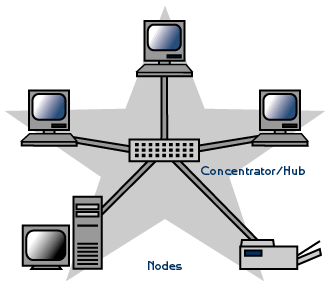A star topology is designed with each node (file server, workstations, and peripherals) connected directly to a central network hub or concentrator
Data on a star network passes through the hub or concentrator before continuing to its destination. The hub or concentrator manages and controls all functions of the network. It also acts as a repeater for the data flow. This configuration is common with twisted pair cable; however, it can also be used with coaxial cable or fiber optic cable.

Advantages of a Star Topology
Easy to install and wire.
No disruptions to the network then connecting or removing devices.
Easy to detect faults and to remove parts.
Disadvantages of a Star Topology
Requires more cable length than a linear topology.
If the hub or concentrator fails, nodes attached are disabled.
More expensive than linear bus topologies because of the cost of the concentrators.